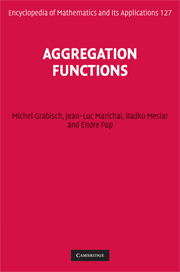Book contents
- Frontmatter
- Contents
- List of figures
- List of tables
- Preface
- 1 Introduction
- 2 Properties for aggregation
- 3 Conjunctive and disjunctive aggregation functions
- 4 Means and averages
- 5 Aggregation functions based on nonadditive integrals
- 6 Construction methods
- 7 Aggregation on specific scale types
- 8 Aggregation on ordinal scales
- 9 Aggregation on bipolar scales
- 10 Behavioral analysis of aggregation functions
- 11 Identification of aggregation functions
- Appendix A Aggregation of infinitely many arguments
- Appendix B Examples and applications
- List of symbols
- References
- Index
Appendix B - Examples and applications
Published online by Cambridge University Press: 05 March 2013
- Frontmatter
- Contents
- List of figures
- List of tables
- Preface
- 1 Introduction
- 2 Properties for aggregation
- 3 Conjunctive and disjunctive aggregation functions
- 4 Means and averages
- 5 Aggregation functions based on nonadditive integrals
- 6 Construction methods
- 7 Aggregation on specific scale types
- 8 Aggregation on ordinal scales
- 9 Aggregation on bipolar scales
- 10 Behavioral analysis of aggregation functions
- 11 Identification of aggregation functions
- Appendix A Aggregation of infinitely many arguments
- Appendix B Examples and applications
- List of symbols
- References
- Index
Summary
Main domains of applications
We give here a commented list of application domains, with references for further study. We do not pretend to be exhaustive, and the reader may consult more application-oriented books on aggregation, e.g., [411].
A first group of applications comes from decision theory. Making decisions often amounts to aggregating scores or preferences on a given set of alternatives, the scores or preferences being obtained from several decision makers, voters, experts, etc., or representing different points of view, criteria, objectives, etc. This concerns decision under multiple criteria or multiple attributes, multiperson decision making, and multiobjective optimization.
A second group is rooted in information or data fusion. The aim is to refine the information on a given set of objects, by fusing several sources. Often, this amounts to making some kind of decision, as in the first group of applications. Typical applications here are pattern recognition and classification, as well as image analysis.
A third group comes from artificial intelligence and fuzzy logic. Aggregation functions are essentially used there as a generalization of logical connectives in rule-based systems (automated reasoning).
Lastly, we mention but do not detail applications related to probability theory. Obviously, copulas play a prominent role there.
Decision making under multiple criteria or attributes Let X represent a set of alternatives (objects of interest on which a decision or selection has to be made, like candidates to hire, projects to fund, apartments to rent, etc.).
Information
- Type
- Chapter
- Information
- Aggregation Functions , pp. 410 - 419Publisher: Cambridge University PressPrint publication year: 2009
